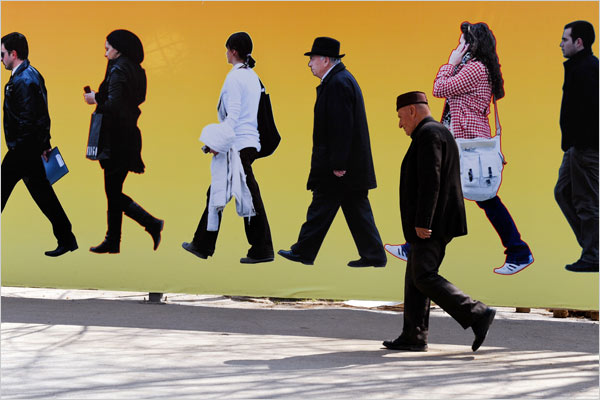There is an ongoing discussion in the public media about the dangers of photographs being altered or otherwise faked. To put it bluntly, you can make good money warning the newspaper reader about the dangers of visual deception. Never mind that many of the quotations and all of the verbal descriptions in that paper will be somewhat inaccurate every day of the week. But the photograph seems so real, we are reminded, whereas everyone knows that words are unreliable.
But people also know that photographs are unreliable. In fact, society now has over 150 years of experience in dealing with photographs–taking pictures, having our pictures taken, showing them to others, examining them as evidence, and seeing them every day in advertisements. One result is that photographs can be used to identify relationships between reality and illusion that are much more interesting than the question of whether an image is true.
On Monday I posted on a photographer’s use of a mirror to help the viewer think about the political spectacle. By showing two political leaders accompanied by their reflections, the photograph highlighted both the performative dimension of political leadership and the public use of images. Today’s photograph shifts out attention from elites to ordinary citizens.
One man walks down a street along life-size photos of six other people in an advertisement. The photo is mildly comic: They could be fellow citizens, were they real; he could fit right into the ad, were he an image. They have been carefully posed to model what the retailer wants people to wear; seemingly by accident and without needing to buy a thing he is wearing clothes that qualify as suitably stylish. The caption embellished the point: “Real style on display as a man walked by an ad for clothes in Pristina, Kosovo.” He is real while the photographs are not real; likewise, his style is real while theirs is imaginary, artificial, fake.
The caption also provides an example of how words are unreliable. The sentence could mean that the ad displays real style while the man walking in front of the ad is but the lesser approximation of that style. That interpretation is less likely because it isn’t supported by the typical contrast between reality and images, or by the real man being placed in the foreground of the photograph. The ambiguity, however, runs deeper than a case of sloppy sentence construction.
Someone ought to say it, so I will: the man isn’t real either. As in the image on Monday, the photograph has created a sense of its own reality through an internal contrast between a transparent image and another that is obviously a copy of something else. We know that the real models are no longer in the advertisement, yet we assume that the man on the street is really there.
This use of visual composition to activate a discourse about illusion to create a reality effect is more than mere deception. I think the image raises a number of interesting questions. Isn’t “real style” located more in the collective imagination rather than individual statement? (Would he be dressed as he is if he didn’t already imagine himself as part of that line, albeit today without the additional items of consumption being promoted in the ad?) Aren’t we always walking down the street amidst imaginary citizens whose presence keeps us on the straight and narrow, provides assurance that the street is safe, allows us to feel both connected and individuated, and otherwise constitutes civic space? Of course, that presence also creates social pressure, distributes social goods unfairly, places unreasonable demands, and leaves us unsatisfied, but it is there as surely as that ad was on display in Kosovo.
In other words, the photograph reveals the role that photojournalism plays in creating the civic strangers populating the imaginary space necessary for citizenship. The man in the photo is in the same relationship to us as the six figures in the ad are to him. He is one of the imaginary citizens placed beside us by the media. Instead of seeing images as copies of real people, why not, once in awhile, see ourselves as people who live among images?
The contrast between image and reality often is used to ward off awareness of how society depends on seeing, copying, and imagination. Photojournalism suggests not only that the contrast might be overrated, but also how it can be used to explore and perhaps understand our virtual world.
Photograph by Amend Nimani/AFP-Getty Images.

The obvious thing is right in front of us and we just don’t see it so many times. I found this article deeply interesting. I’m glad someone wrote about it. I actually think that it opens the debate for many associated topics. From what’s real and what is not to how deep the power of representation of photography goes.